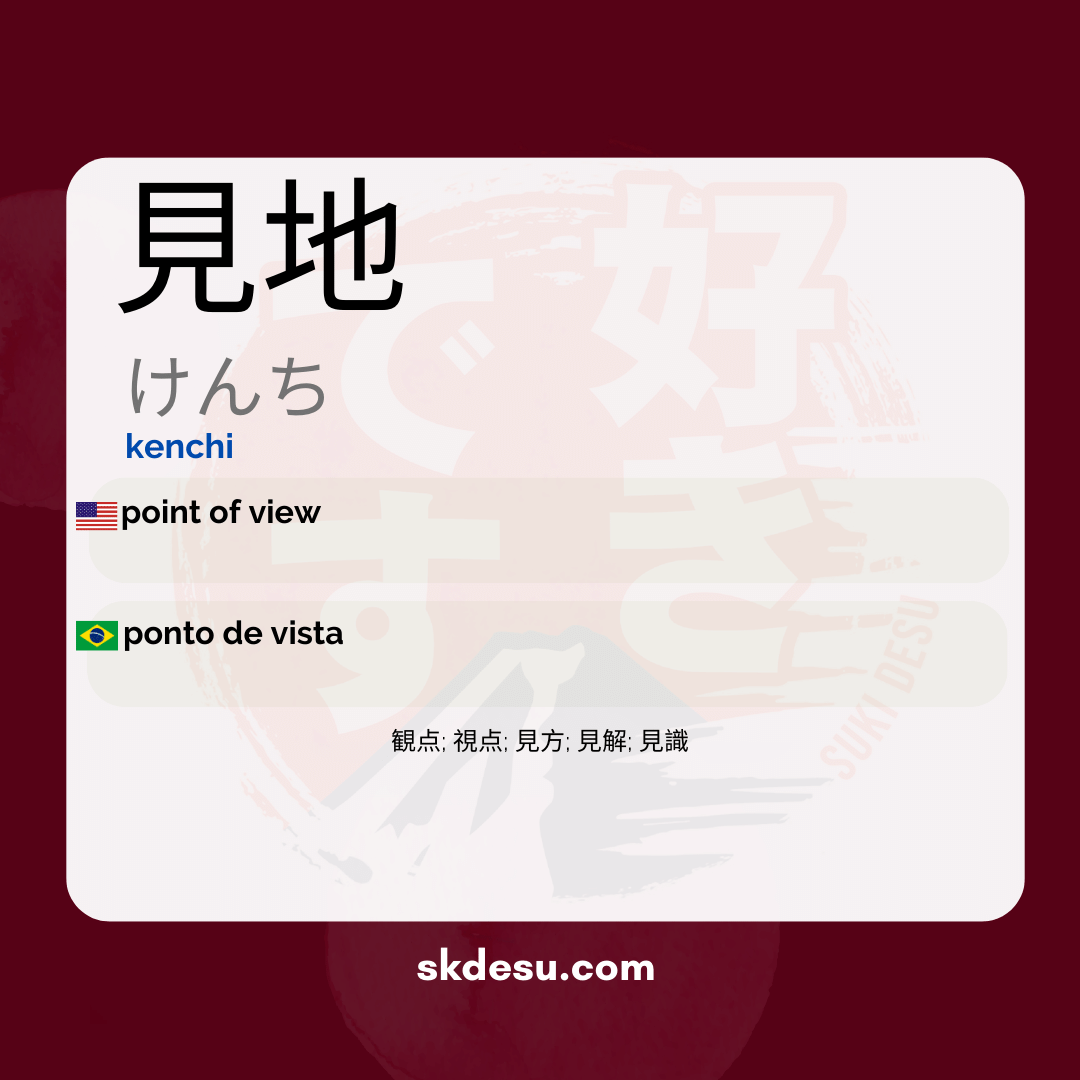Translation and Meaning of: 見地 - kenchi
The Japanese word 見地 (けんち, kenchi) might seem simple at first glance, but it carries interesting nuances worth exploring. Whether you're studying Japanese or just curious about the language, understanding terms like this can enrich your vocabulary and cultural comprehension. In this article, we will uncover the meaning, origin, and practical use of 見地, as well as provide tips for memorizing and applying it correctly. Suki Nihongo, the best online Japanese dictionary, offers accurate information to assist you on this journey.
Meaning and Translation of 見地
見地 is composed of two kanji: 見 (ken, miru), which means "to see" or "to look," and 地 (chi, ji), which can be translated as "earth" or "place." Together, they form a word that refers to a "point of view," "perspective," or "position." In English, we can understand 見地 as the way someone perceives a situation, idea, or problem, often with a more formal or analytical tone.
Unlike words like 意見 (iken, "opinion"), which express personal thoughts, 見地 has a more objective bias, almost like an "angle of analysis." For example, in academic or professional discussions, it is common to use 見地 to refer to a specific approach within a debate. If you want to say "from an economic point of view," you could use "経済的な見地から" (keizaiteki na kenchi kara).
Origin and Cultural Use
The origin of 見地 dates back to classical Chinese, where the characters were already used in similar contexts. In Japan, the word gained prominence during the Edo period (1603-1868), when philosophical and academic discussions became more structured. Since then, it has retained a more formal usage, often appearing in academic texts, reports, and political speeches.
Culturally, 見地 reflects the Japanese appreciation for well-founded analyses and multiple perspectives. Instead of simply expressing an opinion, the term suggests that there is a basis behind that view. This connects with concepts such as 客観性 (kyakkan-sei, "objectivity") and 多角的視点 (takakuteki shiten, "multifaceted view"), common in Japanese communication.
Tips for Memorizing and Using 見地
An effective way to memorize 見地 is to associate its kanji with the meaning. Imagine that 見 represents "to see" and 地 is the "ground" where you are stepping – meaning, your position while observing something. This mental image helps to cement the sense of "point of view." Another tip is to practice with sentences like "彼の見地は興味深い" (kare no kenchi wa kyōmi bukai, "His point of view is interesting").
Avoid confusing 見地 with terms like 視点 (shiten), which also means "perspective" but is more commonly used in everyday conversation. While 視点 appears in informal discussions, 見地 has a more technical tone. If you are writing an article or participating in a formal meeting, prefer 見地 to sound more precise. Otherwise, 視点 may be the more natural choice.
For those who enjoy anime or dramas, pay attention to scenes of debates or strategic discussions – often, 見地 appears in these contexts. Words like this demonstrate how rich Japanese can be in nuances, and mastering them makes all the difference in fluency.
Vocabulary
Expand your vocabulary with related words:
Synonyms and similar words
- 観点 (Kanten) - Point of view or perspective, often used in theoretical or critical discussions.
- 視点 (Shiten) - Angle of view or perspective, often related to how a situation is observed or interpreted.
- 見方 (Mikata) - Way of seeing or approach, emphasizing how someone understands or considers something.
- 見解 (Kenkai) - Opinion or interpretation, involving an analysis or judgment about a specific topic.
- 見識 (Kinshiki) - Knowledge or wisdom, reflecting the experience that shapes someone's view of the world.
Romaji: kenchi
Kana: けんち
Type: noun
L: jlpt-n1
Translation / Meaning: point of view
Meaning in English: point of view
Definition: a stance or idea about something.
Quick Access
- Vocabulary
- Writing
- Sentences
How to Write in Japanese - (見地) kenchi
See below a step-by-step guide on how to write the word by hand in Japanese. (見地) kenchi:
Example Sentences - (見地) kenchi
See below some example sentences:
Watashitachi wa kenchi ga kotonaru
We have different points of view.
We have a different perspective.
- 私たちは - 「私たち」
- 見地 - "Point of view" in Japanese
- が - Japanese grammatical particle that indicates a nominal sentence
- 異なる - "To be different" in Japanese.
Other Words of this Type: noun
See other words from our dictionary that are also: noun

